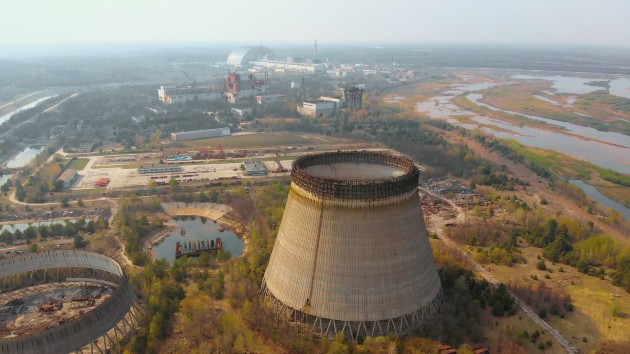DeSid/iStockBy PATRICK REEVELL, ABC News(NEW YORK) — Local guides who offer tours of Chernobyl are counting the cost following huge wildfires that this month ravaged the area around the former nuclear power station.The fires that began at the start of April spread across thousands of acres inside the so-called Exclusion Zone, which surrounds the station in northern Ukraine, at one point coming within less than a mile of the station itself. Hundreds of firefighters struggled to contain the fires but managed to extinguish them after rain fell about two weeks ago, although some areas still continue to smolder. Ukraine’s state emergency service on Monday said that more than 1,000 firefighters were still working to fully extinguish the fires in the zone.The station itself was unharmed, but the flames nevertheless wrought wide destruction on the unique historical locations and natural environment inside the zone, an approximately 1,000-square-mile area that is thickly forested and scattered with abandoned villages and Soviet-era installations.In recent years, Chernobyl has become a popular destination for tourists, intrigued by its dark history and the eerie remnants of the USSR that have been left as if frozen in time since the area was evacuated after the explosion at the power station in 1986. The disaster site in particular has seen a tourist boom following the hit HBO series chronicling the accident last year. About 100,000 people visited in 2019.Abandoned for three decades by humans, the zone has also become in effect a nature reserve, where wildlife has flourished despite elevated radiation levels, including species largely vanished in most of Europe.The fires have destroyed swathes of that habitat and also many tour sites. Drone footage filmed last week shows forests of charred trees and several villages where virtually all the houses had been burned to the ground.Yaroslav Yemelianenko, the head of the Association of Chernobyl Tour Operators who also works with the state agency overseeing the zone, said he thought 30% to 40% of the locations where he took groups had been burned down.”Just looking at it, it seems the entire center of the Chernobyl Exclusion Zone has burnt up,” Yemelianenko told ABC News by phone on Monday.The most famous sites inside the zone have not been destroyed, Yemelianenko said. Besides the station, that includes the ghost city of Pripyat, evacuated in 1986, and Chernobyl-2, a former secret city built round a massive, mysterious Soviet radar installation.“The main locations from a one-day tour were practically unharmed,” Yemelianenko said. But 12 to 15 other locations, including several deserted wooden villages, had been destroyed, as well as two Soviet tourist camps, Fairytale and Emerald, he said.“These were villages that were quite well-preserved,” said Yemelianenko, who also runs the tour firm Chernobyl Tour. “They were not very looted. It was possible, for example, to show with these villages how everyday life was for the people who lived there until the fourth reactor at the power station exploded.”At the height of the fires, Yemelianenko and other guides had frantically sounded the alarm, fearing the situation was out of control and that key sites could be wiped out. That included Pripyat, he said, whose post-apocalyptic cityscape has become an international symbol of Chernobyl.“It was very lucky,” he said, saying he believed only a change in the wind and the deployment of extra firefighters had prevented the fire from reaching the city.The wildfires around Chernobyl had sparked radiation fears, but Ukraine’s authorities have insisted that while radiation levels in the heart of the fires did raise slightly, levels outside the zone never increased, including in the capital Kyiv, 60 miles south.Last week, however, smoke from the fires around the Exclusion Zone and in the nearby Zhitomir region wrapped Kyiv in thick, choking smog, making the city’s air the most polluted in the world. Authorities denied the smog contained any radioactive materials, but residents were still told to remain indoors and close their windows.Wildfires around Chernobyl are common, but this year’s have been far larger than normal, the result in part of an exceptionally dry winter that saw virtually no snow.Police have blamed people burning grass and rubbish for starting the fires, and three people have been arrested in connection with the recent blazes. Ukraine’s government has now steeply increased fines for grass burning and other types of fire-lighting leading to damage.Local guides have blamed the fires also on unauthorized visitors to the zone — nicknamed Stalkers — whose numbers are up because the coronavirus quarantine in Ukraine currently means all official tours are halted.Yemelianenko said in addition to the warm winter, the fires had also spread because the forests around Chernobyl were not managed, with authorities leaving dry undergrowth and failing to dig sufficient fire trenches. He also blamed authorities for failing to send enough firefighters when the fires began.Ukraine’s emergency services have said they kept the fires under control in difficult conditions.Yemelianenko said he believed he and other guides would now seek to turn the losses from the fire into opportunity and suggested they might use virtual reality technology to recreate some areas.But he said he feared the problems that had led to the fires remained and that the area may well see a repeat in the future.”I would like to hope that this fire will change everything and after such an experience that we won’t have a repeat,” he said. “But I look soberly at the world around me, and I understand how it was now and it also can be like that again sometime.”
Copyright © 2020, ABC Audio. All rights reserved.












